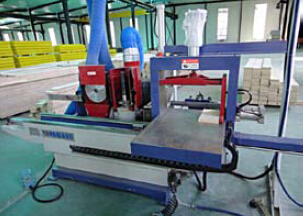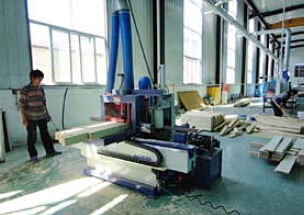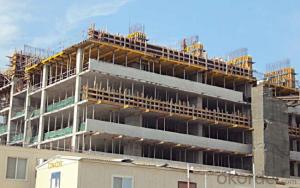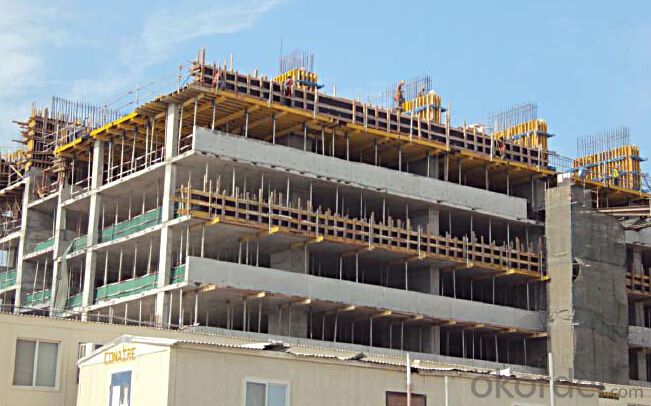Timber-beam formwork H20 for formwork and scaffolding systems
- Loading Port:
- Tianjin
- Payment Terms:
- TT OR LC
- Min Order Qty:
- 50 m²
- Supply Capability:
- 1000 m²/month
OKorder Service Pledge
OKorder Financial Service
You Might Also Like
Characteristics:
◆ Standardized production lines.
Supply capability: 3000m/day, Lmax = 6600mm.
◆ Finger jointing of the flange and web, the strength of timber beam is highly improved.
Max. shearing force failure load:40KN
◆ Well treated to prevent from water penetration or erosion, so the service life maximally
extended.
Normally, CNBM timber beam H20 can be used for 4 to 5 years, the exact using time would
depend on maintenance & storage.
◆ Robust caps at the end of the girders protect against damages.




- Q: Can steel formwork be used in seismic areas?
- Steel formwork is indeed applicable in seismic regions due to its strength, durability, and stability. Its ability to endure the forces and vibrations produced during an earthquake guarantees the safety and stability of the structures under construction. Moreover, the quick construction facilitated by steel formwork is advantageous in seismic areas where timeliness is crucial for ensuring the security of the built environment. Nevertheless, it is vital to ensure that the steel formwork is correctly designed and installed to meet the area's specific seismic design requirements and codes.
- Q: Can steel formwork be used for projects with limited formwork stripping time?
- Yes, steel formwork can be used for projects with limited formwork stripping time. Steel formwork is known for its durability and strength, allowing it to withstand the pressure and load of concrete during the curing process. Additionally, steel formwork is reusable and can be quickly dismantled, making it suitable for projects with tight schedules where formwork stripping needs to be done promptly.
- Q: How does steel formwork affect the overall acoustics of the building?
- The overall acoustics of a building can be greatly influenced by the use of steel formwork. Steel formwork, due to its dense and rigid nature, tends to reflect sound waves rather than absorb them. This reflection can result in increased noise levels and the creation of echoes within the building. The utilization of steel formwork can lead to a longer reverberation time, which is the duration it takes for sound to diminish by 60 decibels. This can result in poor speech clarity and reduced audio quality within the space. Moreover, the sound reflections from steel formwork can disrupt the natural acoustic properties of the room, potentially causing distortion and resonance problems. To tackle these challenges, it is possible to incorporate sound-absorbing materials on the interior surfaces of the building. This can help decrease the reflection and reverberation of sound waves, thereby enhancing the overall acoustics of the space. Possible options include the use of acoustic panels, insulation materials, and ceiling treatments that absorb and scatter sound. When determining the type of formwork to be used, it is crucial to consider the specific requirements of the building and its intended purpose. For spaces where excellent acoustics are essential, such as auditoriums, concert halls, or recording studios, alternative formwork materials that offer superior sound absorption properties might be preferred over steel formwork. However, in other applications where acoustics are less critical, steel formwork can still be utilized effectively by incorporating appropriate sound-absorbing measures. In conclusion, the selection of steel formwork can significantly impact the acoustics of a building. By carefully considering sound absorption and reflection properties, and by implementing additional acoustic treatments, it is possible to mitigate any negative effects and create a more pleasant and functional acoustic environment.
- Q: What are the different types of edge protections available for steel formwork?
- There are several types of edge protections available for steel formwork, each serving a specific purpose and providing different levels of safety and functionality. Some of the common types include: 1. Steel edge protection: This type of edge protection is made of steel and is typically used in heavy-duty construction projects. It provides excellent durability and strength, ensuring the safety of workers and preventing accidental falls. 2. Rubber edge protection: Rubber edge protection is a flexible and lightweight option that offers impact resistance and a cushioning effect. It is commonly used in areas where workers may come into contact with the edge, such as staircases or walkways. 3. Plastic edge protection: Plastic edge protection is lightweight, easy to install, and cost-effective. It provides a barrier between workers and the edge, preventing accidental slips or falls. Plastic edge protection is commonly used in low-risk areas or temporary construction sites. 4. Foam edge protection: Foam edge protection is made of soft and flexible material, providing a cushioning effect and preventing injury if someone accidentally bumps into it. It is typically used in areas where there is less risk of falls but a higher chance of impact. 5. Metal edge protection: Metal edge protection is commonly used in industrial settings where heavy machinery or equipment may come into contact with the edge. It offers excellent durability and protection against impact, ensuring the safety of both workers and equipment. 6. Removable edge protection: This type of edge protection can be easily installed and removed when no longer needed. It is commonly used in areas where temporary edge protection is required, such as during construction or renovation projects. It is essential to choose the appropriate type of edge protection based on the specific requirements of the construction project, considering factors such as the level of risk, durability, ease of installation, and cost-effectiveness.
- Q: How does steel formwork affect the overall project cost?
- Steel formwork can have a significant impact on the overall project cost. It is generally more expensive to use steel formwork compared to other alternatives such as wood or aluminum. However, there are several factors that need to be considered when evaluating the cost-effectiveness of using steel formwork. Firstly, steel formwork is known for its durability and longevity. Unlike wood, steel formwork can be reused multiple times, which can lead to cost savings in the long run. It requires less maintenance and repairs, reducing the need for frequent replacements. This can be particularly advantageous for projects that involve repetitive use of formwork. Secondly, steel formwork offers better quality and precision in terms of concrete finishing. It provides a smoother surface and accurate dimensions, resulting in reduced need for additional finishing work. This can help save both time and money during the construction process. Moreover, steel formwork allows for faster construction compared to other types of formwork. It is quick to assemble and dismantle, enabling faster turnaround times. This can have a positive impact on the overall project schedule and potentially reduce labor costs. Additionally, steel formwork is more resistant to factors such as weather conditions, high pressure, and vibrations. This enhances the overall structural integrity of the concrete, reducing the risk of defects and potential rework. By minimizing the need for corrective actions, steel formwork can help control project costs. However, it is important to note that the cost of steel formwork can vary depending on the project size, complexity, and duration. For smaller projects with limited use of formwork, the cost difference between steel and other materials may not be significant. In such cases, it may be more cost-effective to opt for alternative formwork options. In conclusion, while steel formwork may have a higher upfront cost compared to other materials, its durability, precision, speed, and long-term reusability can contribute to cost savings throughout the project. It is essential to carefully evaluate the specific requirements and circumstances of each project to determine the most cost-effective formwork solution.
- Q: Can steel formwork be used for soundproofing walls?
- No, steel formwork alone cannot be used for soundproofing walls. Soundproofing typically requires the use of specialized materials and techniques, such as acoustic insulation and sound-absorbing panels, to effectively reduce noise transmission.
- Q: What are the different types of surface treatments available for steel formwork?
- Steel formwork offers a variety of surface treatments, each with its own unique benefits and characteristics. One option is galvanization, which involves applying a layer of zinc to the steel. This treatment protects against corrosion, extends durability, and provides a smoother surface finish. Another choice is powder coating, where a dry powder is applied and heated to create a protective layer. This treatment offers excellent resistance to corrosion, impacts, and chemicals, and comes in a wide range of colors. Painting is a common method where a layer of paint is applied for both aesthetics and protection against corrosion and environmental factors. Epoxy coating is another option, involving a layer of epoxy resin that provides resistance to corrosion, chemicals, and abrasion. It also offers easy cleaning and maintenance with its smooth finish. Shot blasting is a process of propelling steel shots onto the surface to remove rust, scale, or contaminants, resulting in a clean and roughened finish. This treatment also improves adhesion for subsequent surface treatments. Although typically used for aluminum formwork, anodizing can also be applied to steel. This treatment creates an oxide layer that enhances corrosion resistance and improves appearance. Overall, the choice of surface treatment for steel formwork depends on factors such as corrosion resistance, aesthetics, durability, and environmental conditions. It is important to consider these factors before selecting the most suitable treatment.
- Q: Are there any specific considerations for using steel formwork in areas with limited space?
- Yes, there are a few specific considerations when using steel formwork in areas with limited space. Firstly, the dimensions of the steel formwork need to be carefully planned to ensure it can fit within the confined space. Additionally, the assembly and disassembly process should be efficient and require minimal space. It is also important to consider the weight of the steel formwork and ensure that it can be safely maneuvered within the limited space. Lastly, proper coordination with other construction activities and equipment is necessary to avoid any clashes or hindrances in the limited space.
- Q: Can steel formwork be used for both above-ground and below-ground structures?
- Certainly, steel formwork is applicable for both above-ground and below-ground structures. Known for its strength, durability, and versatility, steel formwork proves itself suitable for a variety of construction projects. For instance, above-ground structures like buildings and bridges typically require formwork in order to shape and support the concrete during the casting process. Steel formwork, with its robustness and stability, effectively withstands the weight and pressure exerted by the concrete. Likewise, below-ground structures such as basements, tunnels, and foundations can also derive benefits from steel formwork. These structures often necessitate formwork to achieve the desired shape and provide support during the pouring and curing phases of concrete. The resilience of steel formwork enables it to withstand the pressure exerted by the surrounding soil and groundwater, thus ensuring the structural integrity. Furthermore, steel formwork presents additional advantages, including reusability, ease of assembly and disassembly, and resistance to harsh environmental conditions. These qualities render steel formwork an excellent choice for both above-ground and below-ground construction projects, where durability and efficiency are paramount. Nevertheless, it is crucial to take into account the specific requirements of each project and seek guidance from structural engineers and construction experts to ensure the selection of an appropriate formwork system.
- Q: Can steel formwork be used for both horizontal and vertical concrete elements?
- Yes, steel formwork can be used for both horizontal and vertical concrete elements. Steel formwork provides strength, stability, and durability, making it suitable for a wide range of construction projects. Its versatility allows for the creation of various shapes and sizes, making it a preferred choice for both horizontal slabs and vertical walls.
Send your message to us
Timber-beam formwork H20 for formwork and scaffolding systems
- Loading Port:
- Tianjin
- Payment Terms:
- TT OR LC
- Min Order Qty:
- 50 m²
- Supply Capability:
- 1000 m²/month
OKorder Service Pledge
OKorder Financial Service
Similar products
Hot products
Hot Searches
Related keywords

















